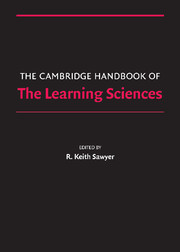Book contents
- Frontmatter
- Contents
- Preface
- Contributors
- 1 Introduction
- PART I FOUNDATIONS
- PART II METHODOLOGIES
- PART III THE NATURE OF KNOWLEDGE
- PART IV MAKING KNOWLEDGE VISIBLE
- PART V LEARNING TOGETHER
- 24 Computer-Supported Collaborative Learning
- 25 WILD for Learning
- 26 Arguing to Learn
- 27 Learning in Online Communities
- PART VI LEARNING ENVIRONMENTS
- Afterword: After How Comes What
- Epilogue: The Fundamental Issue in the Learning Sciences
- Author Index
- Subject Index
- References
24 - Computer-Supported Collaborative Learning
Published online by Cambridge University Press: 05 June 2012
- Frontmatter
- Contents
- Preface
- Contributors
- 1 Introduction
- PART I FOUNDATIONS
- PART II METHODOLOGIES
- PART III THE NATURE OF KNOWLEDGE
- PART IV MAKING KNOWLEDGE VISIBLE
- PART V LEARNING TOGETHER
- 24 Computer-Supported Collaborative Learning
- 25 WILD for Learning
- 26 Arguing to Learn
- 27 Learning in Online Communities
- PART VI LEARNING ENVIRONMENTS
- Afterword: After How Comes What
- Epilogue: The Fundamental Issue in the Learning Sciences
- Author Index
- Subject Index
- References
Summary
Computer-supported collaborative learning (CSCL) is an emerging branch of the learning sciences. It is concerned with studying how people can learn together with the help of computers.
As we will see in this chapter, such a simple statement conceals considerable complexity. The interplay of learning with technology turns out to be quite intricate. The inclusion of collaboration, computer mediation, and distance education has problematized the very notion of learning and called into question prevailing assumptions about how to study it.
Like many active fields of scientific research, CSCL has a complex relationship to established disciplines, it evolves in ways that are hard to pinpoint, and it includes important contributions that seem incompatible. The field of CSCL has a long history of controversy about its theory, methods, and definition. Furthermore, it is important to view CSCL as a vision of what may be possible with computers and of what kinds of research should be conducted, rather than as an established body of broadly accepted laboratory and classroom practices. We start from some popular understandings of the issues of CSCL and gradually reveal its more complex nature.
CSCL Within Education
As the study of particular forms of learning, CSCL is intimately concerned with education. It considers all levels of formal education from kindergarten through graduate study as well as informal education, such as in museums.
Information
- Type
- Chapter
- Information
- The Cambridge Handbook of the Learning Sciences , pp. 409 - 426Publisher: Cambridge University PressPrint publication year: 2005
References
Accessibility standard: Unknown
Why this information is here
This section outlines the accessibility features of this content - including support for screen readers, full keyboard navigation and high-contrast display options. This may not be relevant for you.Accessibility Information
- 155
- Cited by
